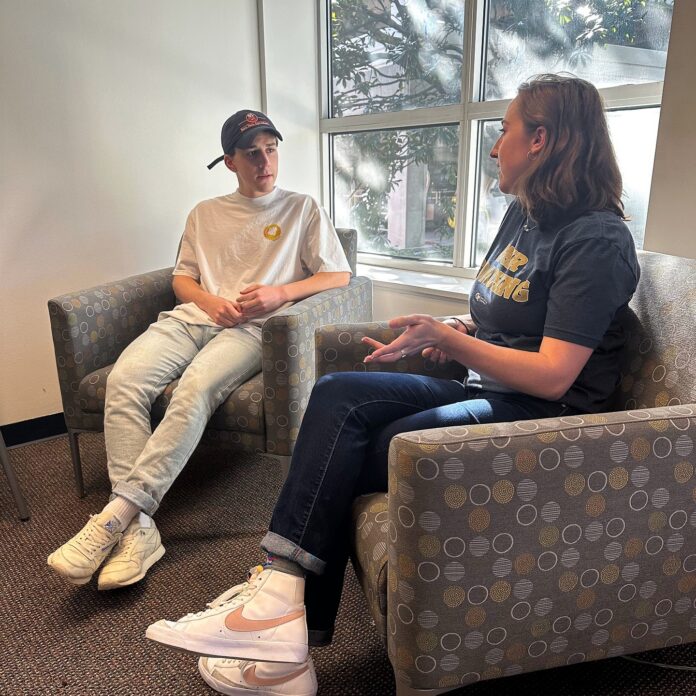
PART TWO: WHY DOES SYNESTHESIA HAPPEN?
So, we know a bit about what synesthesia is. But what actually causes these remarkable perceptions?
Well the truth is, as usual, that no one really knows for sure. There is strong evidence for a genetic component to synesthesia, as it tends to run in families. Despite this, however, it isn’t inherited directly- that is, the type of synesthesia, in terms of what stimuli will produce what sensory responses, doesn’t seem to be inherited at all. If your mother had lexical-gustatory synesthesia, for example, you are statistically more likely to have some form of synesthesia, but there is no preference towards synesthesia involving vision or taste. This, along with the fact that many people have more than one type of synesthesia, suggests that all forms of developmental synesthesia share some common cause and genetic predisposition (Ward). What this genetic component actually does is still contentiously debated though.
Investigations into synesthesia have been going on for many years. In 1690, John Locke wrote about a blind man who described the color scarlet as “the sound of a trumpet”, and the first well-documented case of synesthesia dates all the way back to 1812, when an Austrian doctor named Georg Sachs included descriptions of his own synesthesia in his medical dissertation (Ward). When the scientist Cornaz reviewed Sach’s paper again in 1848, it generated a lot of interest in the phenomena, and many more cases of synesthesia were discovered and investigated. Cornaz, however, thought that the color-grapheme synesthesia Sachs experienced was related simply to his eyes. He suggested that it was a result of having more color receptors in the eye, and therefore being able to detect additional colors that others couldn’t see (Ward). This explanation has been widely rejected, but it did spark the first significant interest in synesthesia, and people began to suggest other possibilities, such as Lusanna’s 1873 proposal that the “cerebral organs” for music, language and color might be close to each other and might overlap or connect in people with synesthesia (Ward).
Interest in synesthesia seems to have waned during the early 1900s, but it was definitely revitalized in the 1980s, after the neurologist Richard Cytowic published several case studies and a popular book, “The Man Who Tasted Shapes”, about synesthesia. Although his suggestion that synesthesia might be related to the limbic system has also been discredited, he played a huge role in bringing attention back to synesthesia and starting a new era of neuroscientific and psychological research into it.
In terms of the current research into the neural mechanism for what is happening in the sensory systems of synesthetes, there seem to be two major competing schools of thought. One views synesthesia as a result of structural differences in the brain and nervous system, and the other claims that it is due to functional differences in use of the neural circuits we all have. To break down each of these hypotheses, we can look a bit more closely into the arguments of each:
| Team Structural Differences |
| As the researcher Baron-Cohen sees it, synesthesia is best explained by a difference in the number of connections in the brain- more and unusually strong neural pathways could allow for a physical connection between areas of the brain that typically respond to different senses/stimuli. It has also been suggested, by Dr. Daphne Maurer, that everyone is born with these additional connections, but that they are typically lost are we grow. Under this proposal, synesthesia is therefore a result of changes in development that neglect to “prune” these connections (Carpenter).
There is data to support the idea that the brains of people with synesthesia are physically different than those without it. Among the many imaging studies that have been done, a study by Weiss and Fink 2009 found that the intraparietal sulcus had more gray matter in people with color-grapheme synesthesia, and that it is also activated when those participants were viewing graphemes. In addition, imaging data from Rouw and Scholte 2007 found that people with color-grapheme synesthesia had significantly increased white matter connectivity in brain regions they believe to be implicated with synesthesia. |
| Team Functional Changes |
| Some scientists think that synesthesia is better explained as the result of using the same brain architecture and connections, but in a different way. Proponents of this hypothesis focus on neural pathways common to everyone, but generally inhibited, or blocked, in one direction. Having that pathway be disinhibited would then allow people with synesthesia to distribute information between these neurons differently (Carpenter, Grossenbacher and Lovelace 2001).
For synesthesia, the major pathways considered are those that function with our sensory systems. A simplified version of these networks goes something like this: Information is carried from receptor cells across the body to different regions of the brain, where it is processed, put into context with the activity of other neurons, and used to form a comprehensive picture of the situation. Then, once the input has been consolidated, and a conscious perception or decision about the course of action has been made, the brain can send feedback and further instructions to the appropriate areas in what are called feed-backward connections. The idea, then, is that in synesthesia, the inhibitory nature of some feed-backward connections of the sensory systems is deactivated or “disinhibited”, which means that information may be flowing down paths and/or in directions it normally couldn’t. This would allow a stimulus to interact with the system differently, and potentially “mix” information from multiple sensory inputs or areas, causing synesthesia (Carpenter). Grossenbacher, a lead advocate for this approach to looking a synesthesia, claims that this explanation is supported by the fact that certain drugs, such as LSD, can produce temporary synesthetic experiences. “I don’t think that new connections are forming in the brains of those individuals for a few hours and then disappearing,” he says. “What’s much more sensible is that existing connections become used in a way that’s neurochemically altered for a few hours.” (Carpenter). What may actually be causing the disinhibition of these pathways, on a molecular level, isn’t known yet. |
As with all complex scientific concepts, there are no easy answers when it comes to synesthesia, and as always, there are many suggested explanations. The “Teams” above are definitely not divided into black-and-white, entirely separate categories, and many have suggested ideas that combine different aspects of each theory we’ve discussed, along with novel insights.
The most interesting proposals I’ve found are briefly summarized below:
According to scientists, synesthesia could be due to…
- greater communication in the feed-backward paths (due to either disinhibition or unusual neural connections, both of which could be genetically regulated (Ramachandran).
- Abnormal connections in the brain (possibly genetic) from resulting from:
- the way that excess connections are pruned during development (Carpenter, Ramachandran, Ward).
- the growth of more neural connections than is normal (Ramachandran, Ward).
- Changed axon-guidance, or pathway formation, that the connections will follow (Ward).
- Disruption of the formation of border regions in the brain (Ward).
- Border regions are essentially blockers between adjacent regions, made by inhibition or simply a lack of connections between the areas.
Whatever the true cause of synesthesia is, there is no debating the fact that it is absolutely remarkable. Synesthesia has also had tremendous impact on culture over time as well, with many influential artists, musicians, and writers purported to have a form of synesthesia. If you want to read about the way that synesthesia has affected a few people who have it, as well as society at large, check out Part Three here: http://chargedmagazine.org/2019/10/painting-with-all-the-colors-of-the-wind-part-three/
References
Carpenter, S. (2001, March). Everyday fantasia: The world of synesthesia. American Psychological Association, 32(3).
Grossenbacher, P. G., & Lovelace, C. T. (2001). Mechanisms of synesthesia: Cognitive and physiological constraints. Trends in Cognitive Sciences,5(1), 36-41. doi:10.1016/s1364-6613(00)01571-0
Hubbard, E. M., & Ramachandran, V. (2005). Neurocognitive Mechanisms of Synesthesia. Neuron,48(3), 509-520. doi:10.1016/j.neuron.2005.10.012
Ramachandran, V.S., Hubbard, E.M. and Butcher, P.A. (2004). Synesthesia, CrossActivation, and the Foundations of Neuroepistemology. In G. Calvert, C. Spence and B. E. Stein (eds), The Handbook of Multisensory Processes (pp. 867-83). Cambridge, Mass.: The MIT Press.
Rouw, R., & Scholte, S. (2010). Increased structural connectivity in Grapheme-Color Synesthesia. Journal of Vision,7(9), 108-108. doi:10.1167/7.9.108
Ward, J. (2013). Synesthesia. Annual Review of Psychology,64(1), 49-75. doi:10.1146/annurev-psych-113011-143840


